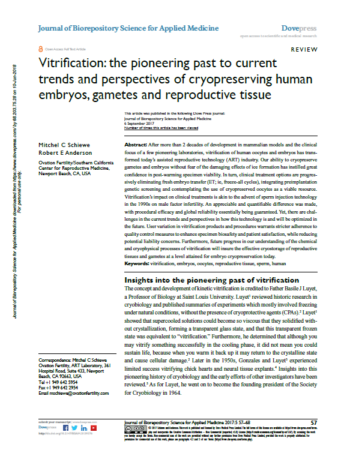Mitchel C Schiewe, Robert E Anderson
Ovation Fertility/Southern California Center for Reproductive Medicine, Newport Beach, CA, USA
 Abstract: After more than 2 decades of development in mammalian models and the clinical focus of a few pioneering laboratories, vitrification of human oocytes and embryos has transformed today’s assisted reproductive technology (ART) industry. Our ability to cryopreserve gametes and embryos without fear of the damaging effects of ice formation has instilled great confidence in post-warming specimen viability. In turn, clinical treatment options are progressively eliminating fresh embryo transfer (ET; ie, freeze-all cycles), integrating preimplantation genetic screening and contemplating the use of cryopreserved oocytes as a viable resource. Vitrification’s impact on clinical treatments is akin to the advent of sperm injection technology in the 1990s on male factor infertility. An appreciable and quantifiable difference was made, with procedural efficacy and global reliability essentially being guaranteed. Yet, there are challenges in the current trends and perspectives in how this technology is and will be optimized in the future. User variation in vitrification products and procedures warrants stricter adherence to quality control measures to enhance specimen biosafety and patient satisfaction, while reducing potential liability concerns. Furthermore, future progress in our understanding of the chemical and cryophysical processes of vitrification will insure the effective cryostorage of reproductive tissues and gametes at a level attained for embryo cryopreservation today.
Abstract: After more than 2 decades of development in mammalian models and the clinical focus of a few pioneering laboratories, vitrification of human oocytes and embryos has transformed today’s assisted reproductive technology (ART) industry. Our ability to cryopreserve gametes and embryos without fear of the damaging effects of ice formation has instilled great confidence in post-warming specimen viability. In turn, clinical treatment options are progressively eliminating fresh embryo transfer (ET; ie, freeze-all cycles), integrating preimplantation genetic screening and contemplating the use of cryopreserved oocytes as a viable resource. Vitrification’s impact on clinical treatments is akin to the advent of sperm injection technology in the 1990s on male factor infertility. An appreciable and quantifiable difference was made, with procedural efficacy and global reliability essentially being guaranteed. Yet, there are challenges in the current trends and perspectives in how this technology is and will be optimized in the future. User variation in vitrification products and procedures warrants stricter adherence to quality control measures to enhance specimen biosafety and patient satisfaction, while reducing potential liability concerns. Furthermore, future progress in our understanding of the chemical and cryophysical processes of vitrification will insure the effective cryostorage of reproductive tissues and gametes at a level attained for embryo cryopreservation today.